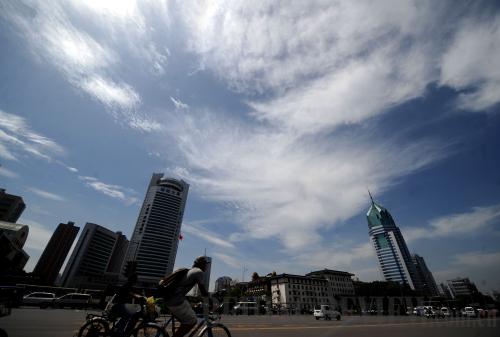|
 |
|
BLACK TO GREEN: North China's Shanxi Province, renowned as the coal capital of the country, finished its sulfur dioxide emissions reduction task ahead of schedule in 2009. The picture shows the province's capital city Taiyuan on August 10, 2009 (YAN YAN) |
Environmental Protection Minister Zhou Shengxian announced emission reduction targets for 2010 and 2009's achievements at a national environmental protection work conference in Beijing on January 25. In 2010, sulfur dioxide emissions will be cut by 400,000 tons and chemical oxygen demand will be reduced by another 200,000 tons after reaching previous goals.
Zhou said sulfur dioxide emission reduction task set in the 11th Five-Year Plan (2006-10) was reached a year ahead of schedule in 2009. The country also achieved 97 percent of its task of reducing chemical oxygen demand last year, so Zhou expects to easily complete the task in 2010.
The 11th Five-Year Plan set goals to reduce emissions of major pollutants, such as sulfur dioxide and chemical oxygen demand, a measure of water pollution, by 10 percent from 2006 to 2010.
Emissions of sulfur dioxide in China dropped 10.4 percent last year compared with that of 2008, according to Zhou.
Zhou also said sulfur dioxide emissions were down 24.6 percent compared with that of 2005.
According to the statistics of the Ministry of Environmental Protection (MOEP), in 2006, the first year of the 11th Five-Year Plan, most area of China did not complete the task of emissions reduction. The MOEP issued warnings to local governments that they needed to take emission reductions into consideration or the country would not reach its goals.
In 2007, the national total discharge of pollutants decreased for the first time, marking a turning point in China.
Some expressed doubts about whether the numbers were accurate, since they went up in 2006 and years before but went down suddenly in 2007. But Zhou said the Central Government began a series of assessment programs in 2006 and 2007 that included emission reduction results as one of the factors for evaluating local cadres. The State Council began publishing a list of emission reduction results from different areas twice a year. In 2009, the MOEP gave warnings to eight provinces that were slow in reducing emissions.
Pressure to reduce emissions thus passed from the Central Government to local governments. For example, the Shandong Provincial Government imposed administrative sanctions on leaders of the cities and counties that did not complete emission reduction tasks in the province.
Over the last two years, a large number of pollution treatment facilities including sewage treatment plants and power plant desulfurization facilities began operating across the country. Zhou said there were more than 30 sewage treatment plants being put into operation daily in some provinces.
Data from the MOEP show that the investment in desulfurization equipment over the course of the five-year plan is equal to that spent over previous decades.
Some critics have said that the MOEP is just playing a numbers game to ensure that the task is completed ahead of schedule. Zhou responded by offering proof that environmental quality has improved in many areas throughout the country. Among 113 key environmental protection cities, 65.5 percent achieved better air quality, an increase of 8 percent compared to 2008.
Zhou said the United States saw more evidence of the positive results on China's emission reductions when it collected data with its global satellite observation system. The data they collected showed that sulfur dioxide emissions in 2007 went down and continued to significantly drop in the ensuing years.
While some experts are optimistic about achieving the environmental protection tasks set forth in the 11th Five-Year Plan, Zhou said he has concerns because each area has different emission reduction goals and some still have a long way to go to reach their targets. Zhou added the leadership must be held responsible in areas that are unable to complete the task and no new industrial projects will be allowed to start there. Every province, autonomous region and municipality should produce for the State Council a written report on emission reductions from 2006 to 2010, he said. | 